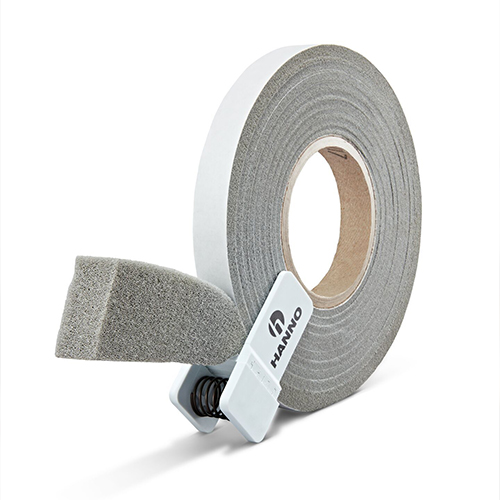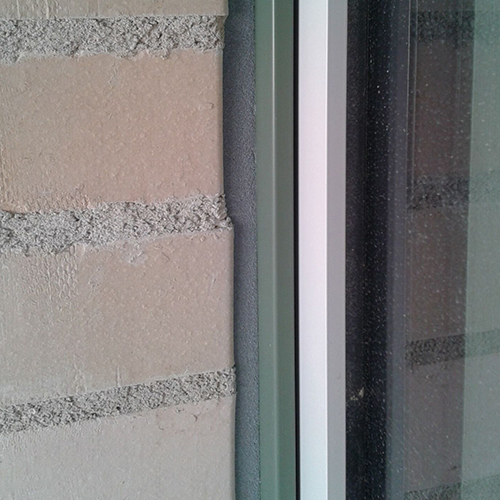Jürgen Maurer interview: Joint tape with physical effect

Jürgen Maurer is Managing Director of Hanno (Schweiz) AG.

The pre-compressed Hannoband physically seals joints for up to 15 years and is harmless to health.

The 接缝密封胶带 in light grey goes well with the joint mortar of an exposed brickwork.
Mr Maurer, when should joint sealants on façades be planned?
This should ideally be done during the planning phase in order to determine the joint sealant in the best possible way. Ideally, the architect should select the specific products himself. However, experience shows that the joint sealants are often only determined at the construction site, so that the joints are then often too narrow or too large and thus no professional sealing can be carried out. The joints must not be less than eight millimetres and not more than 35 millimetres for a standard-compliant seal.
What must be taken into account in the planning?
The joints must have a certain width in order to ensure a permanent and functioning waterproofing 按照 the standards. This also ensures that building movements are safely absorbed in the joint. In the façade, it is enormously important that the movement absorption, UV resistance, driving rain resistance, wind tightness, sound insulation as well as fire protection function permanently.
How time-consuming is the installation of your joint tapes in a dilatation joint?
The接缝密封胶带 "Hannoband BG1" and "Hannoband BG1-M" are pre-compressed on the roll and are simply inserted into the joint. They are self-adhesive. This means that they can easily be placed in the desired position with a spatula. The tape then opens automatically in the joint, which means that the installation time is much shorter than with a sealant.
How does the installation work in winter?
Our 接缝密封胶带 can be applied without any problems even in sub-zero temperatures and wet conditions, as it is pressed and not glued. There is also no need for priming, as joints can also be uneven, damp and dusty. The pre-compressed sealing tape compresses between the joint flanks and thus ensures tightness through the contact pressure.
With sealant joints, you often see a flank tear, which makes the joint leaky. How does the pre-compressed 接缝密封胶带 behave?
Since the 接缝密封胶带 is permanently compressed in the joint, a flank tear is impossible. Hanno guarantees the functionality of its BG1接缝密封胶带 for up to 15 years, including UV and weather resistance. All tapes are also tested according to DIN 18542/2009.
What colours are available? And can the tape also be painted over?
The tapes are available in light grey, grey and black. Light grey is very suitable for exposed brickwork. This is because joint mortar is also usually light grey, so the tapes are almost invisible.
The接缝密封胶带 can only be painted over with a diffusion-open facade paint to a limited extent: Since the paint adheres very well to the tapes, but does not usually absorb any movements that occur, this can result in small cracks in the paint, which, however, can only be seen from very close up. Of course, the tightness of the接缝密封胶带 is not affected by these cracks because the tape adapts to the joint despite the paint.
Is joint renovation in the façade possible with a 接缝密封胶带?
It is actually much easier, safer and more durable than with a sealant. When renovating with sealant, the old sealant should be removed without leaving any residue, as the adhesive bond to the substrate must be ensured. Incompatibility and repulsion of the different sealants must also be expected. Since a 接缝密封胶带 does not require an adhesive bond to the substrate, it is sufficient to simply cut out the old sealant and then insert the 接缝密封胶带. That's it!
Now to the windows: Are there differences between plastic windows and other types of windows?
Wooden frames are easy to seal because they have a smooth surface. Plastic frames and metal frames, on the other hand, are profiled on the sides. Sealing these is not so easy. Hanno has therefore subjected the functionality of its 密封系统 to a component test. For this purpose, a "Hannoband BG1" was applied to the back of the frame of a PVC window without using a profile filler.
What about fire protection?
We have a special tape in our range for this: "Hannoband BSB BG1" meets the requirements of耐火等级up to EI 120, with VKF approval.
The bonding of building components and the foaming of cavities is sometimes criticised because the components are often connected in such a way that they are difficult to separate during dismantling. What solutions are there?
This is a clear argument in favour of接缝密封胶带, which guarantee tightness only through their contact pressure, without gluing. This makes replacement and removal easy at any time.
What do you say to concerns that joint sealants emit substances that are harmful to health?
Here too,接缝密封胶带 made of PU foams offer a safe and ecological alternative. Reacted polyurethane no longer contains harmful monomers and isocyanates. Isocyanates can cause allergies and are suspected of causing cancer. Our tapes are EC1Plus-tested and approved for Minergie-Eco buildings. Emicode EC1Plus is the seal for particularly low-emission and ecological building products that exceeds the standard category EC1. For the classification, the sum of volatile (VOC), carcinogenic and low volatile (SVOC) organic compounds is tested after three and 28 days respectively.
This interview was conducted in cooperation with Hanno (Schweiz) AG.
_________________
The Sissach-based company Hanno (Schweiz) AG was founded in 2000 as an independent branch of Hanno Werk GmbH & Co. KG, which has its headquarters in Laatzen, Germany. Among other things, the company specialises in sealing connection joints in building construction and sound insulation.


